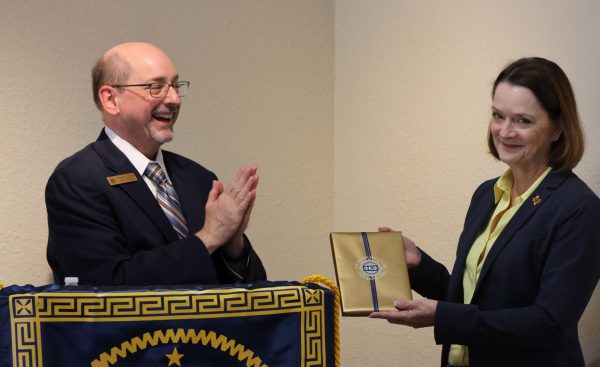Suzanne Shipley’s “To Go With the One I Love” Part four
President Suzanne Shipley addresses attendees at the beginning of the Board of Regents meeting, Nov. 7, 2019. Previously president of MSU Texas, Shipley has taken up writing.
After seeing Shira through three parts of turmoil, exile and love, the fourth and final part of Suzanne Shipley’s “To Go With the One I Love” cleaned up the loose ends readers were aching to leave behind in the dust. A long anticipated confession of love between Shira and Gray placed a fine point on part three and led swiftly into an immediate confrontation of Achim and Francesca. After the two of them practically sold Shira into an internment camp so they could run away together, it was satisfying to see them narratively smacked around a bit. Agent Bauer, an obnoxious Nazi, officer shows his face again. Though Bauer wasn’t relevant enough to mention in prior reviews, it’s worth mentioning that his character functioned largely as a plot motivator by way of traumatizing Shira. Though not exactly a confrontation, Bauer is conveniently a terrible person and was caught attempting to rape Shira’s sister. This is then used as leverage to fire him.
There is an argument to be made about what the purpose of this book is. If the purpose of this book is to give an accurate account of a young Jewish woman finding life and love during the Holocaust, the convenient happy ending reads as an overly optimistic and, perhaps, naive way to end Shira’s story. If the purpose of the book is to give a perfect, positive story to a fictional Jewish girl in the Holocaust, the ending completes that goal but still comes off as a bit shallow. Either interpretation leaves room for improvement. There are too many details about the Shira’s trauma and the abuse of the Nazis for the reader to buy into such a sun-dazed ending. Perhaps it’s naive for a reader to expect a sobered, realistic ending for a quick romance across Europe, but if Shipley were to write a cute, fluffy romance, it calls into question why she would choose Nazi Europe as its backdrop at all. This extreme contrast puts the reader in the awkward position of deciding whether they should take “To Go With the One I Love” seriously. This could be remedied by reassessing the tone throughout the book through characters’ reactions.

This wavering tone is seen most clearly in this part when Shira finds out in a letter from Gray that her Bubbe has died. After spending weeks in Nazi jail plagued with dreams and worries of Bubbe, it takes multiple chapters before Shira even reacts to this part of the letter. Her first reaction is that she needs to get herself ready for her lover to be home. Perhaps she was pushing off those feelings but readers are left to guess what Shira feels about it.
Part four of this novel wasn’t necessarily worse than the other parts; it simply underscored some hard-to-ignore issues that permeated the length of the novel. Despite these critiques, I enjoyed reading the story overall. Enjoyment and critical analysis are two separate things. While the novel needs to be in the hands of an editor or professional publisher before it’s truly polished, it was fun to read. For those looking for a quick escape and can ignore a few character development issues, “To Go With the One I Love” scratches the historical romance itch in its brief 301 pages.

Hello there! I’m Abigail Jones, your business manager. I’m a mass communication junior with a focus in public relations and advertising. I have a french...









